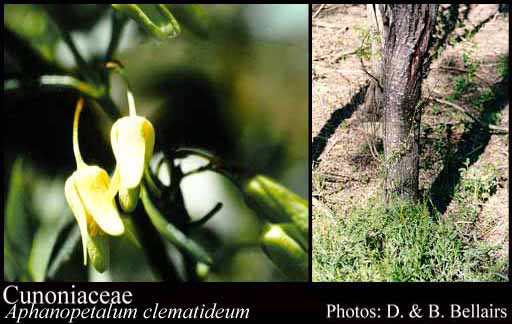This name is not current. Find out more information on related names.
- Reference
- Voy.Terra Austral. 2:548 (1814)
- Name Status
- Not Current

Scientific Description
Common name. Cunonia Family.
Habit and leaf form. Trees, shrubs, and lianas. Self supporting, or climbing. Leaves opposite, or whorled, or alternate (rarely); when alternate, spiral (Gumillea); leathery; petiolate; nearly always compound, or simple (sometimes); when compound, ternate, or pinnate; often conspicuously with stipules. Stipules interpetiolar (often), or intrapetiolar. Leaves without a persistent basal meristem. Domatia recorded (from 3 genera); represented by pits, or pockets, or hair tufts. Stem anatomy. Nodes tri-lacunar. Secondary thickening developing from a conventional cambial ring.
Reproductive type, pollination. Fertile flowers hermaphrodite, or functionally male, or functionally female, or hermaphrodite, functionally male, and functionally female. Unisexual flowers present (rarely), or absent. Plants hermaphrodite (usually), or dioecious, or androdioecious (rarely), or gynodioecious (rarely), or polygamomonoecious (rarely).
Inflorescence and flower features. Flowers solitary, or aggregated in ‘inflorescences’; in cymes, in racemes, and in heads. The terminal inflorescence unit cymose, or racemose. Inflorescences usually compound. Flowers small; regular; cyclic, or partially acyclic. Sometimes the androecium acyclic. Hypogynous disk present (commonly), or absent. Perianth with distinct calyx and corolla, or sepaline; (3–)5(–10), or (6–)10(–20); 1 -whorled, or 2 -whorled; isomerous. Calyx (3–)4–5(–10); 1 -whorled; polysepalous, or gamosepalous (basally); imbricate, or valvate; regular. Corolla when present, (3–)4–5(–10) (alternating with the calyx); 1 -whorled; polypetalous, or gamopetalous (basally); regular. Fertile stamens present, or absent (in female flowers). Androecium 4–5 (in one whorl opposite the calyx), or 8–10 (in two whorls), or 20–100 (often ‘many’). Androecial members free of the perianth; all equal; free of one another; 1 -whorled, or 2 -whorled. Androecium exclusively of fertile stamens. Stamens 4–5, or 8–10, or 11–40; isomerous with the perianth, or diplostemonous, or polystemonous; when in one whorl, oppositisepalous. Anthers dorsifixed; versatile (mostly), or non-versatile (Aphanopetalum); dehiscing via longitudinal slits; introrse. Pollen shed as single grains. Fertile gynoecium present, or absent (in male flowers). Gynoecium 2 carpelled (usually), or 3–5 carpelled (rarely). The pistil 2(–5) celled. Gynoecium syncarpous, or apocarpous (more or less, rarely); synovarious (usually), or eu-apocarpous to semicarpous (rarely); superior (usually), or partly inferior (Spiraeanthemum). Ovary plurilocular; when syncarpous 2 locular (usually), or 3–5 locular (rarely). Styles 2, or 3–5; free. Stigmas dry type; papillate; Group II type. Placentation axile, or apical. Ovules 2–50 per locule (i.e. to ‘many’); non-arillate; anatropous, or hemianatropous.
Fruit and seed features. Fruit fleshy, or non-fleshy; not an aggregate, or an aggregate to not an aggregate. The fruiting carpel when apocarpous/semicarpous (i.e. rarely), dehiscent; a follicle. Fruit when syncarpous (i.e. usually), dehiscent, or indehiscent, or a schizocarp; a capsule (usually), or a drupe (rarely), or a nut (rarely). Seeds endospermic. Endosperm oily. Seeds small; winged, or wingless. Cotyledons 2. Embryo usually straight. Micropyle zigzag. Seedling. Germination phanerocotylar.
Physiology, biochemistry. Aluminium accumulation demonstrated (often).
Geography, cytology, number of species. World distribution: Malaysia, Australasia, South Africa, Central and South America - mostly between 13 degrees North and 35 South. X = 12, 15, 16. 250 species.